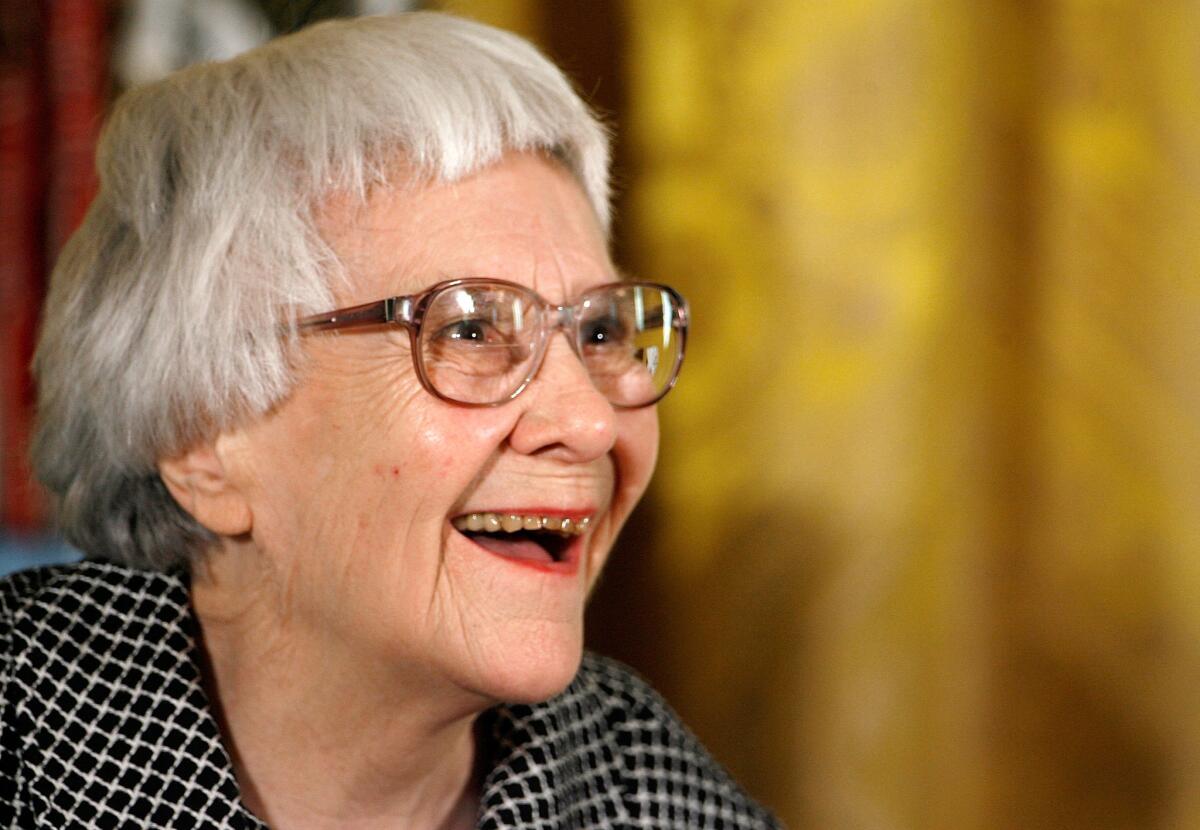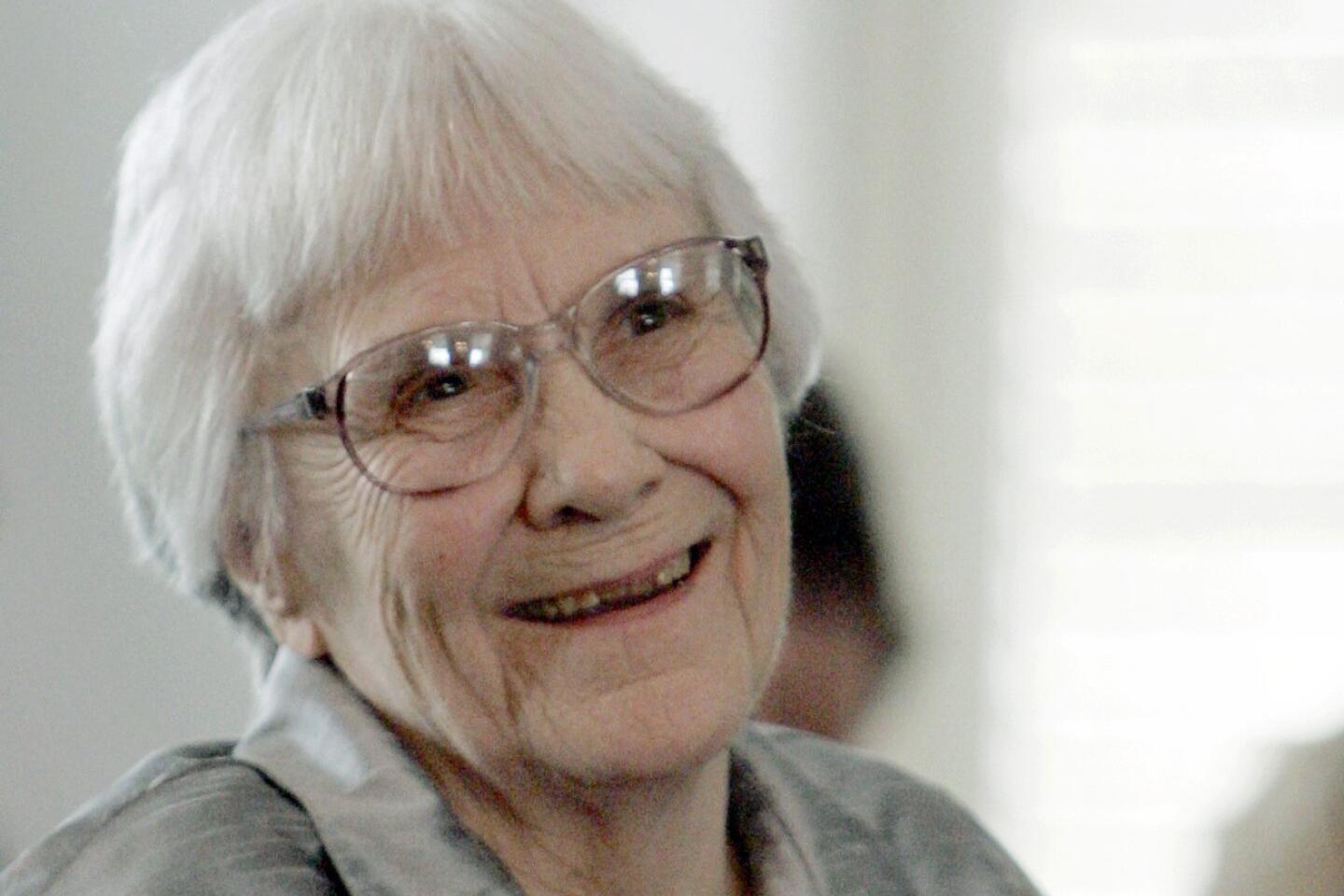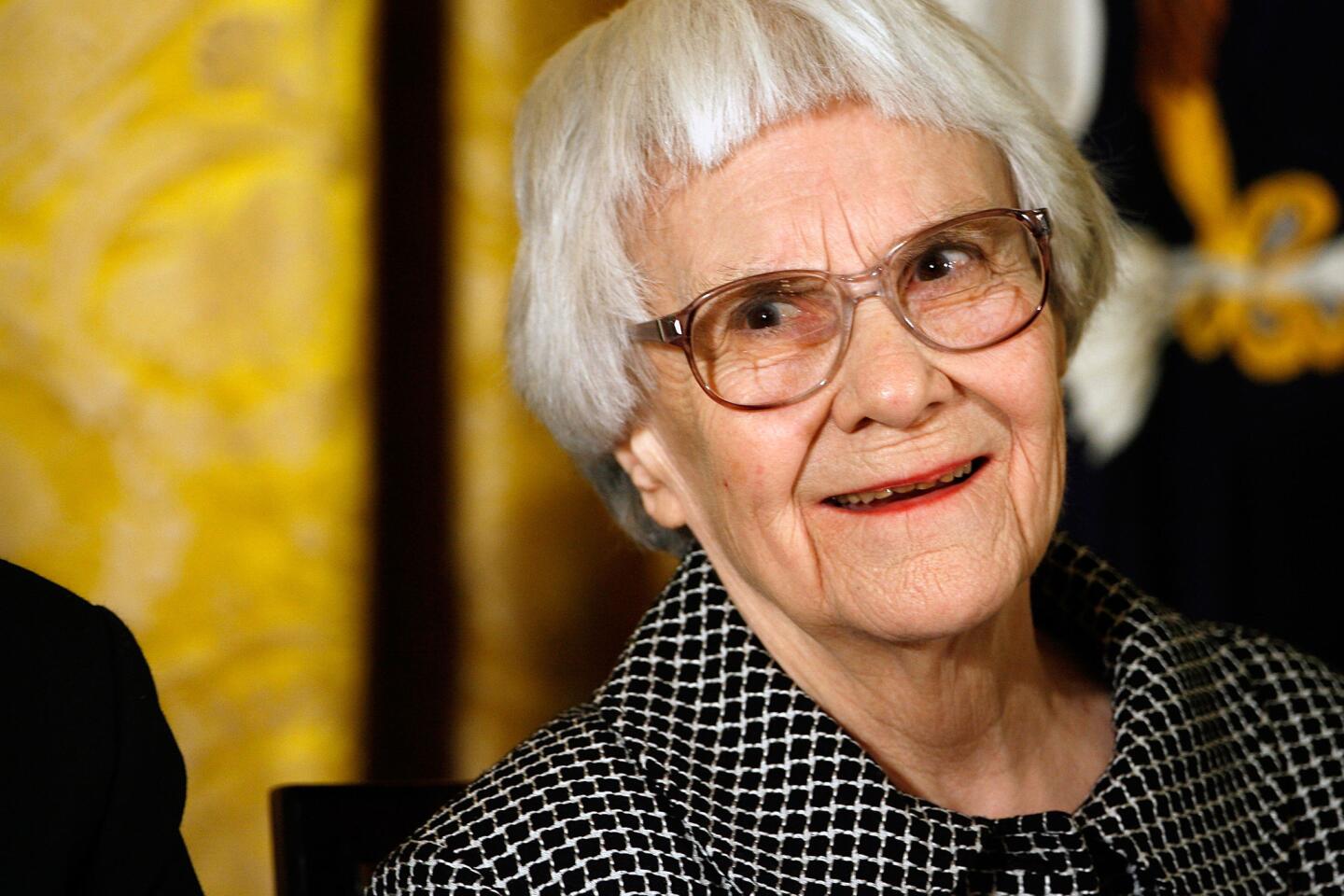Harper Lee, author of classic novel ‘To Kill a Mockingbird,’ dies at 89

Harper Lee, author of “To Kill a Mockingbird,” has died at 89.
“To Kill a Mockingbird,” the classic 1960 novel about racism in a small Southern town, won the Pulitzer Prize for fiction, became a staple of high school reading lists and turned its author into one of American literature’s most revered figures.
But fame and its burdens overwhelmed Harper Lee, who wrote one masterpiece, then shut the door on an adoring public. She had hoped for modest approval of her debut work “but I got rather a whole lot,” she once said, “and in some ways this was just about as frightening.”
------------
For the Record
Harper Lee: In the Feb. 20 Section A, the obituary of author Harper Lee included a 2011 quote from her sister about Lee’s frailties, but incorrectly said she was disputing a claim that Lee had cooperated on a memoir. The quote saying Lee “can’t see and can’t hear and will sign anything put before her by anyone in whom she has confidence” referred to a letter Lee issued saying she hadn’t cooperated on the memoir. Also, an earlier version of the obituary said the character of Atticus in “Go Set a Watchman” denounces segregation. In “Watchman,” he opposes desegregation efforts.
------------
Her literary silence lasted 55 years, until a second manuscript suddenly surfaced: “Go Set a Watchman,” written before “Mockingbird” but set 20 years later, was published in 2015 amid tremendous fanfare and record-breaking sales. Yet it only deepened the mystery surrounding Lee.
What impact did “To Kill a Mockingbird” have on you? Join the conversation on Facebook
Where had the manuscript been all those years? Was it a sequel to “Mockingbird” or just the first draft? Was the decision to publish it really Lee’s? Or had the octogenarian author, struggling with the infirmities of age, been manipulated to release a work she had buried so long?
Lee, as had been her habit, gave no interviews, remaining an enigma until her death on Friday. The author, whose death at 89 was confirmed by publisher HarperCollins and officials in her hometown of Monroeville, Ala., sparked a national conversation about racism with “To Kill a Mockingbird.”
Loosely based on her life growing up in the small Alabama town of Monroeville in the 1930s, it was a coming-of-age story as well as a gripping tale of injustice, told from the perspective of a rambunctious 6-year-old girl named Scout. She is awakened to the ugly realities of life in the Old Confederacy when her lawyer father, Atticus Finch, defends a black man accused of raping a white woman.
Other central characters include Scout’s daredevil older brother Jem, local recluse Boo Radley, the Finches’ black housekeeper Calpurnia, and Scout’s and Jem’s playmate, Dill.
Dill, Lee later said, was based on her childhood friend Truman Capote, who spent summers at his relatives’ house next door to the Lees. The two remained close as writers, with Lee providing crucial reporting help when Capote went to Kansas in 1959 to investigate a murder that became the focal point of his most famous book, “In Cold Blood.”
Scout, Dill and the others were all outsiders in some sense, a plight at the core of “Mockingbird” and its lessons. “You never really understand a person until you consider things from his point of view,” Atticus tells Scout. “Until you climb inside of his skin and walk around in it.”
One of the reasons for the book’s enduring appeal is that it “asks one of the most important questions facing humans — how to get along with people different from us,” said Charles J. Shields, who wrote a well-regarded 2006 biography of Lee, called “Mockingbird.”
“To Kill a Mockingbird” has never been out of print, with more than 40 million copies sold in at least 40 languages. Major polls have ranked it close behind the Bible as one of the most influential books ever written. President George W. Bush said the novel “influenced the character of our country for the better” when he awarded Lee the Presidential Medal of Honor in 2007.
Hollywood bolstered the book’s standing in popular culture with a faithful 1962 adaptation that earned three Academy Awards, including one for Gregory Peck as the noble Atticus, a character the American Film Institute later named the greatest movie hero of the 20th century.
“Go Set a Watchman” offers a darker examination of the conditions that would drive the civil rights campaigns of the ’60s.
It takes place in the same fictional town, Maycomb, with most of the same characters. But Scout is a young woman of 26 who goes by her proper name, Jean Louise. And Atticus is no longer her guiding light.
The principled idealist whose earlier portrayal inspired generations of lawyers, teachers and activists is, in “Watchman,” a racist who has mingled with Ku Klux Klan members and denounces desegregation. “Do you want Negroes by the carload in our schools and churches and theaters? Do you want them in our world?” he asks his daughter.
Most critics said “Watchman” was a seriously flawed work, more interesting as artifact than literature.
Michiko Kakutani in the New York Times called it “a lumpy tale about a young woman’s grief over her discovery of her father’s bigoted views” and found it lacking the lyricism of “Mockingbird.” Other critics were more welcoming, such as the Guardian’s Mark Lawson, who called the new work “a pleasure, revelation and genuine literary event, akin to the discovery of extra sections from T.S. Eliot’s ‘The Waste Land’ or a missing act from ‘Hamlet’ hinting that the prince may have killed his father.”
The old manuscript was discovered in a bank vault by Lee’s lawyer, Tonja B. Carter. Her accounts of the discovery varied; she said she might have handled it in 2011 without realizing what it was, but in 2014 she ascertained that it was not, as she first believed, merely a rough draft of “Mockingbird.”
The sudden appearance of a second novel raised suspicions that Lee, who had a stroke in 2007, was not fully engaged in the decision to publish it. HarperCollins announced the book’s release just a few months after the death of Alice Lee, the author’s older sister and a prominent local attorney (Lee called her “Atticus in a skirt”), who had long acted as her legal and literary guardian.
In 2011, Alice had commented on her sister’s frailties. “Poor Nelle Harper can’t see and can’t hear and will sign anything put before her by anyone in whom she has confidence,” Alice, calling her sister by her given name, wrote in a statement disputing a claim that Lee had cooperated with writer Marja Mills’ memoir about them.
Alabama investigators, acting on a complaint that Lee had been tricked into publishing the second novel, interviewed the author at her Monroeville nursing home but determined that she had consented to its publication.
“Watchman” became HarperCollins’ fastest-selling book, with sales that exceeded 1 million copies in the first week alone.
The book provided scholars and others with new clues about the literary legend who had so avoided the limelight for so long. Like the grown-up Scout of “Watchman,” Lee had left her tight-knit family to build a separate life in New York, but ultimately heeded the call to go home.
“Hell is eternal apartness,” she wrote in “Watchman” about the young woman who struggles with disillusionment after she returns to the South.
“What had she done that she must spend the rest of her years reaching out with yearning for them, making secret trips to long ago, making no journey to the present? I am their blood and bones, I have dug in this ground, this is my home. But I am not their blood, the ground doesn’t care who digs it, I am a stranger at a cocktail party.”
Nelle Harper Lee was born in Monroeville on April 28, 1926, the youngest of four children of Frances Finch and Amasa Coleman Lee. She was a precocious child who read better than most of her classmates. And she was, like the fictional Scout, a tomboy who, according to biographer Shields, “rebelled at everything her mother valued.”
Capote would later use Lee as the model for the wild Idabel Thompkins in his first novel, “Other Voices, Other Rooms,” published in 1948.
Lee’s mother was often sick, leaving much of her upbringing to the family’s black housekeeper, Hattie. Lee was close to her father, an attorney and editor of the local paper, and often sat in the courthouse gallery to watch him try cases. One day he brought home an old typewriter, thinking his highly imaginative daughter and her friend Truman would be able to entertain themselves with it, which they did, writing stories and plays in her backyard.
At Huntingdon College for women in Montgomery, Ala., Lee stood out because of her salty language, aversion to dresses and affinity for smoking pipes. She later transferred to the University of Alabama, where she was editor of the campus paper and studied law.
After spending the summer of 1948 studying literature at Oxford University in England, however, she dropped out of law school a semester short of earning a degree and poured her energies into becoming a writer. In 1949 she moved to New York City.
For several years she supported herself as an airline reservations clerk, reserving her nights and weekends for writing stories that recalled her life in a small Southern town.
Her mother, who had diabetes and was overweight, died in 1951; weeks later, Lee’s brother Edwin died of a cerebral hemorrhage at age 30.
In 1957 she showed a handful of stories to an agent, Maurice Crain, who urged her to develop one of them into a novel, but Lee hesitated, afraid that her job would not leave her enough time to write.
Then came the Christmas present she would never forget.
Lee had befriended other writers in New York, including Michael and Joy Brown, a couple who drew her into their family circle. Although not affluent, they had had a good year. That Christmas they wrote a check that provided Lee with enough money to live on for a year.
Lee quit her job to write full time. Five months later, she had a manuscript that her agent deemed good enough to send to publishers, including J.B. Lippincott. The title was “Go Set a Watchman,” a title derived from the Old Testament verse in which Isaiah foresees the fall of Babylon.
“There were many things wrong about it,” Tay Hohoff, who became her editor at Lippincott, later wrote of Lee’s first effort. “It was more a collection of short stories than a true novel. And yet, there was also life.… The people walked solidly on the pages; they could be seen and heard and felt.”
Hohoff advised the young writer to recast the story from Scout’s eyes. “I was a first-time writer,” Lee said in a statement released decades later, when the publication of “Watchman” was announced, “so I did what I was told.”
After more than two years of rewriting — during a tense period in the South following Supreme Court rulings on the desegregation of public schools and buses — “Mockingbird” was published on July 11, 1960. It was featured by three major book clubs — Reader’s Digest, the Literary Guild and Book-of-the-Month Club — and shot to the top of bestseller lists, where it remained for nearly two years.
Despite resounding commercial success, it received mixed notices from critics. Atlantic Monthly found the story “frankly and completely impossible, being told in the first person by a 6-year-old girl with the prose style of a well-educated adult.” But Time magazine wrote that Lee “cuts through cant, and she teaches the reader an astonishing number of useful truths about little girls and about Southern life.”
The first half of the novel offers a nostalgic vision of small-town Southern life, focusing on the preoccupations and misadventures of Scout, Jem and Dill. They are obsessed with drawing out Boo Radley, the recluse neighbor rumored to eat raw squirrels and stalk the streets at night.
The second half explores the effect on the children of the case of Tom Robinson, a black tenant farmer accused of rape by one of the town’s poor whites. Much to the outrage of Atticus’ neighbors in racially divided Maycomb, the lawyer presents a solid, if doomed, defense of Robinson.
The trial in the book is often compared to the famous Scottsboro case, which took place in Alabama in the 1930s when Lee was about Scout’s age. The case, which involved nine African American defendants wrongly accused of rape, twice went up to the U.S. Supreme Court and stood as an example of a jury system weighted against blacks.
When asked soon after “Mockingbird” was published what message her book sent, Lee said she never intended it as “an indictment so much as a plea for something, a reminder to people at home.”
The title of the novel is drawn from Atticus’ words to his children after he gives them air rifles as presents: “Shoot all the bluejays you want … but remember it’s a sin to shoot mockingbirds.”
When Scout asks her neighbor, Miss Maudie, what her father means, the woman replies: “Mockingbirds don’t do one thing but make music for us to enjoy. They don’t eat up people’s gardens, don’t nest in corncribs, they don’t do one thing but sing their hearts out for us.”
There are at least two “mockingbirds” in the book: Robinson and Radley. Among the great satisfactions of the book are the children’s gradual recognition of the deep injustice suffered by Robinson and their acceptance of Radley, who emerges from the shadows in their moment of deepest crisis.
The book’s phenomenal success brought the world to Lee’s door. In a 1964 interview with Roy Newquist, she said it felt “like being hit over the head and knocked cold.”
Over the next half century, she turned down nearly every interview request, often with a surly “Hell, no!” On one of the rare occasions when she assented — the 50th anniversary of the publication of “Mockingbird” — she told the reporter she would answer questions only if the book was not mentioned.
Her aversion to the spotlight brought comparisons to J.D. Salinger, another literary legend whose reputation rested on a sole novel, “Catcher in the Rye.” He died in 2010.
But unlike Salinger, who had a hearty contempt for the public, Lee was not a recluse. She was often seen around town eating out with friends and made some public appearances, including an annual awards ceremony at the University of Alabama for student winners of an essay contest on her famous novel.
Friends and family described her as a sociable, generous and warm-hearted person with a good sense of humor. In a set of letters sold at auction recently, Lee displayed her wit in comical aliases, signing off as “the Prisoner of Zenda” or “Francesca da Rimini,” the ill-fated nobleman’s daughter whom Dante turned into a character in his “Divine Comedy.”
Although she said she was working on another novel after “Mockingbird,” that prospect was all but forgotten as the years passed. She hinted that the possibility of failure weighed heavily on her.
“When you’re at the top,” she once told a relative, “there’s only one way to go.”
The absence of a second novel gave rise to a stubborn rumor: that Capote had helped write “To Kill a Mockingbird.” Lee never publicly commented on the speculation, but sister Alice dismissed it as “the biggest lie ever told.”
Capote, who was said to be jealous of his friend’s Pulitzer, never completely refuted the rumor; he died in 1984.
Lee also was silent on the controversy that arose in later years over her agent, Samuel Pinkus. In 2007, when she was 80 and unable to hear or see clearly, she signed a document giving Pinkus the copyright to “Mockingbird.” Her lawyer later said she had no idea she had assigned him the rights and sued to regain the copyright and control over millions of dollars in royalties. The copyright was returned to Lee in 2012.
Lee never married and had no immediate survivors. She outlived her sister Alice, with whom she lived for many years until poor health forced each of them into nursing homes.
Alice Lee died in November 2014 at 103.
Less than three months later came the astounding announcement that a second novel would soon be in readers’ hands. Booksellers and fans alike fizzed with anticipation, and pre-sales soared.
The quiet author gave no interviews, but statements released by her publisher suggested that, like much of the rest of the world, she rejoiced in publishing again.
“I’m alive and kicking,” she said, “and happy as hell.”
Woo and Nelson are former Times staff writers. Former staff writers Nick Owchar and Claudia Luther contributed to this report.
MORE ON HARPER LEE
Where has Harper Lee been since ‘To Kill a Mockingbird’ was published?
Harper Lee’s legacy looms over ‘Watchman’ celebrations in Monroeville, Ala.
Rereading ‘To Kill a Mockingbird’: It lingers, but not in the way he expected
More to Read
The biggest entertainment stories
Get our big stories about Hollywood, film, television, music, arts, culture and more right in your inbox as soon as they publish.
You may occasionally receive promotional content from the Los Angeles Times.














